Abstract
When urea is added to Ureaplasma urealyticum, it is hydrolysed internally by a cytosolic urease. Under our measuring conditions, and at an external pH of 6.0, urea hydrolysis caused an ammonia chemical potential equivalent to almost 80 mV and, simultaneously, an increase in proton electrochemical potential (delta p) of about 24 mV with resultant de novo ATP synthesis. Inhibition of the urease with the potent inhibitor flurofamide abolished both the chemical potential and the increase of delta p such that ATP synthesis was reduced to approximately 5% of normally obtained levels. Uncouplers of electrochemical gradients had little or no effect on these systems. The electrochemical parameters and ATP synthesis were measured similarly at three other external pH values. Any change in delta p was primarily via membrane potential (delta psi), and the level of de novo ATP synthesis was related to the increase in delta p generated upon addition of urea and more closely to the ammonia chemical potential. Although the organisms lack an effective mechanism for internal pH homeostasis, they maintained a constant delta pH. The data reported are consistent with, and give evidence for, the direct involvement of a chemiosmotic mechanism in the generation of around 95% of the ATP by this organism. Furthermore, the data suggest that the ATP-generating system is coupled to urea hydrolysis by the cytosolic urease via an ammonia chemical potential.
Full text
PDF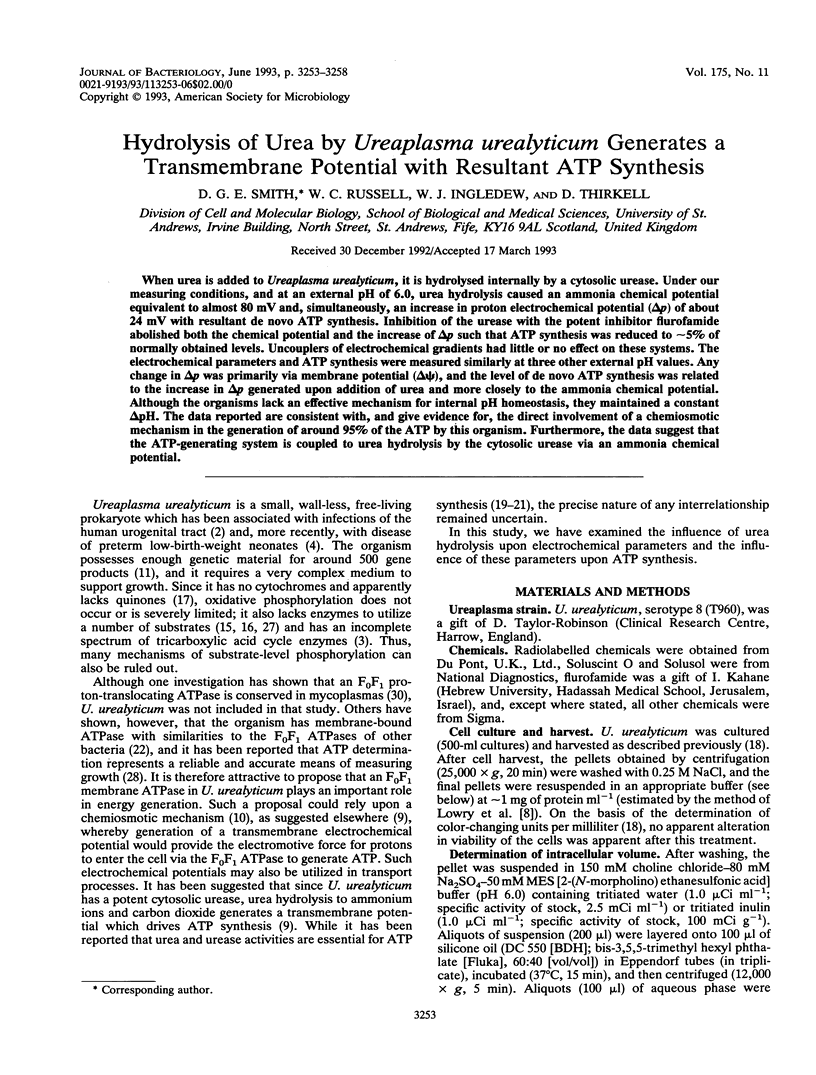
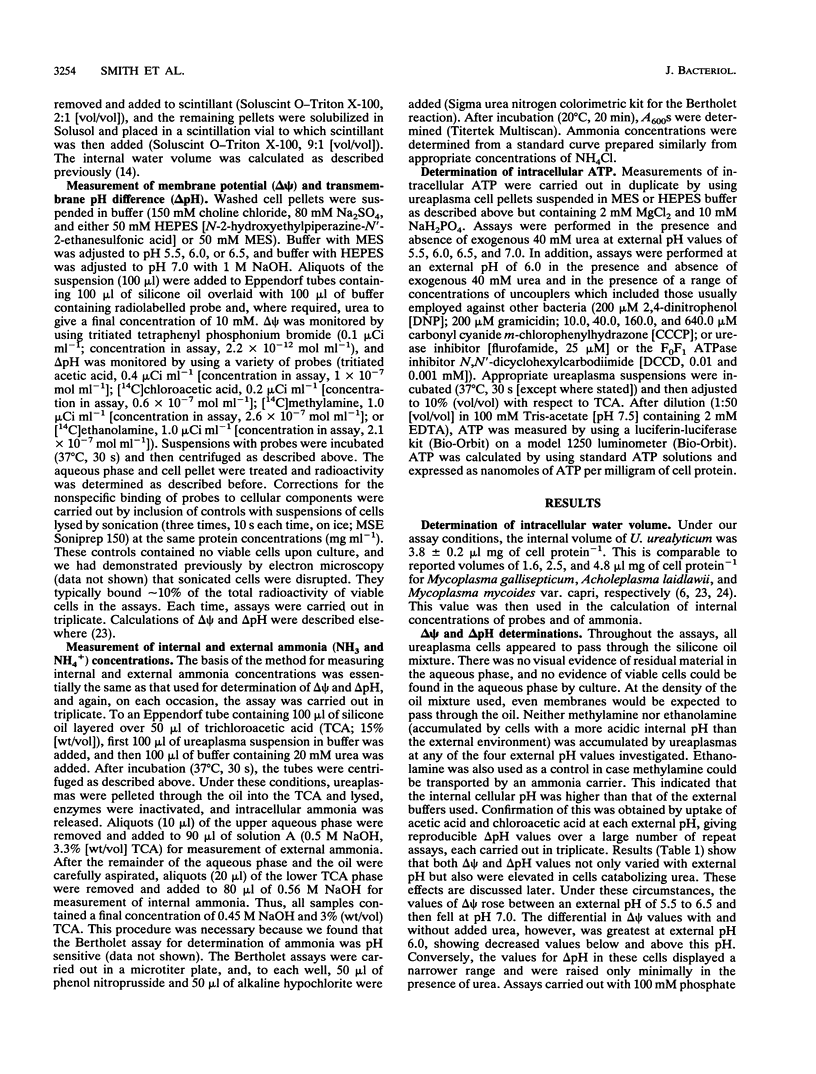
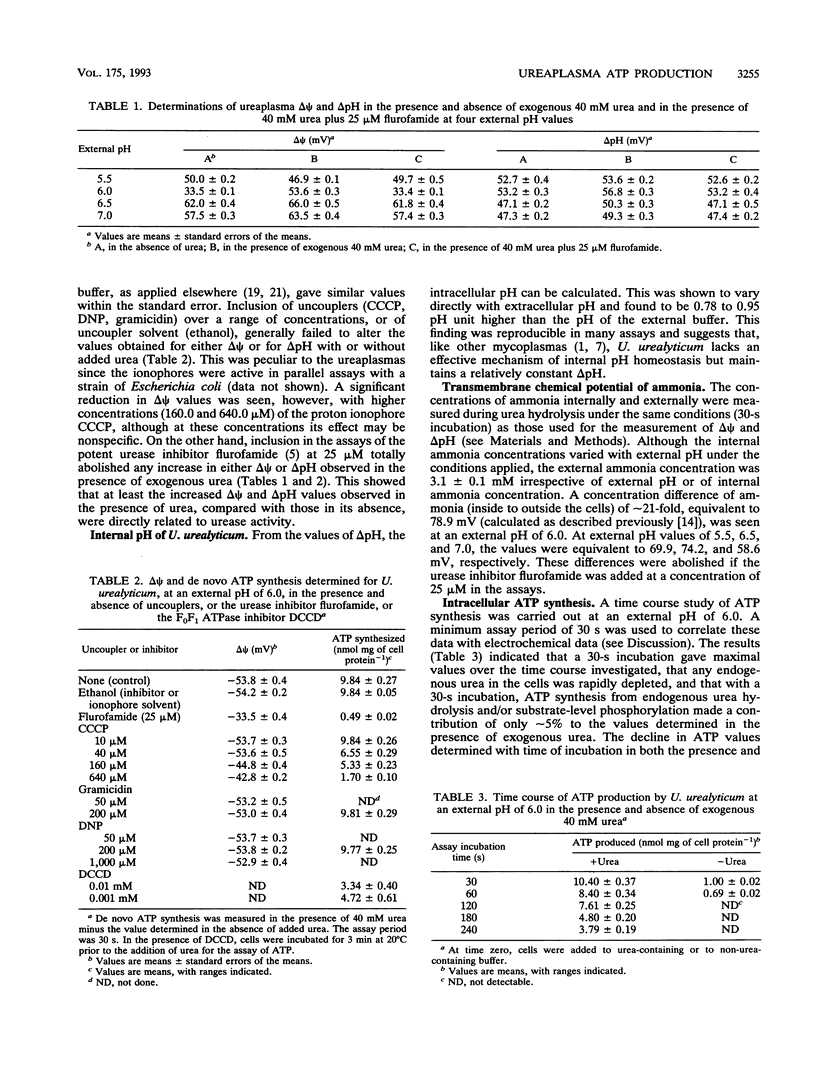
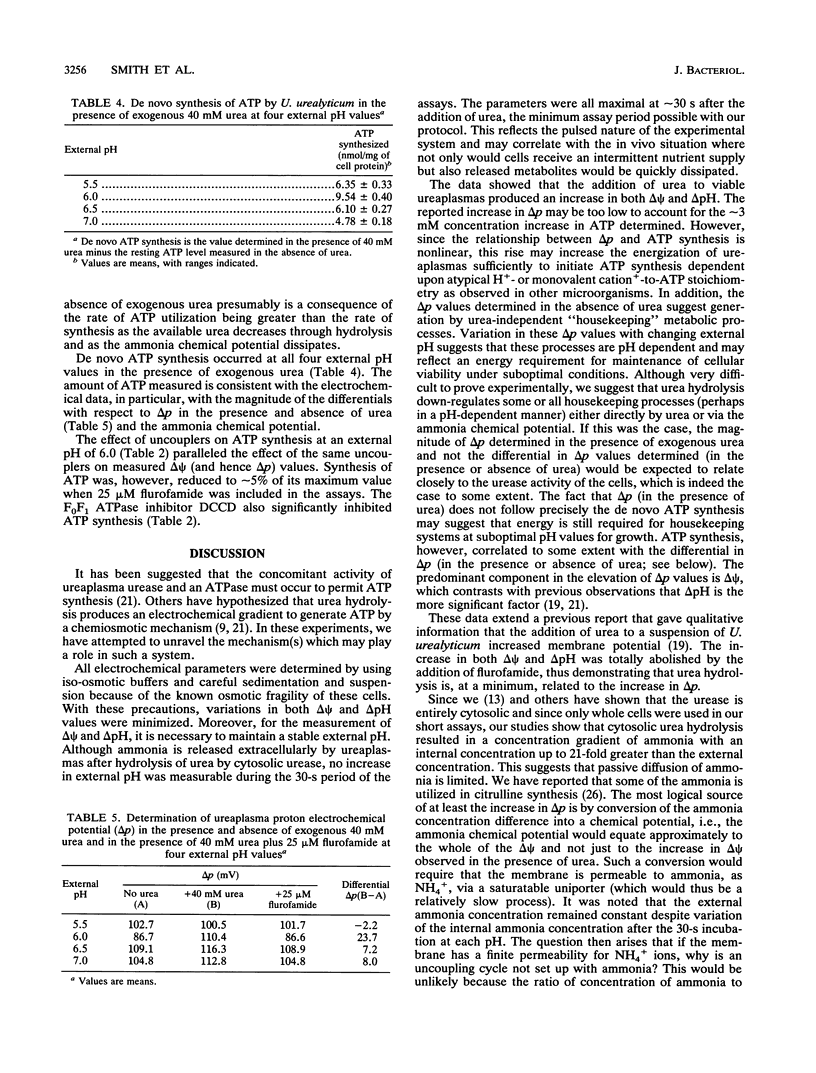
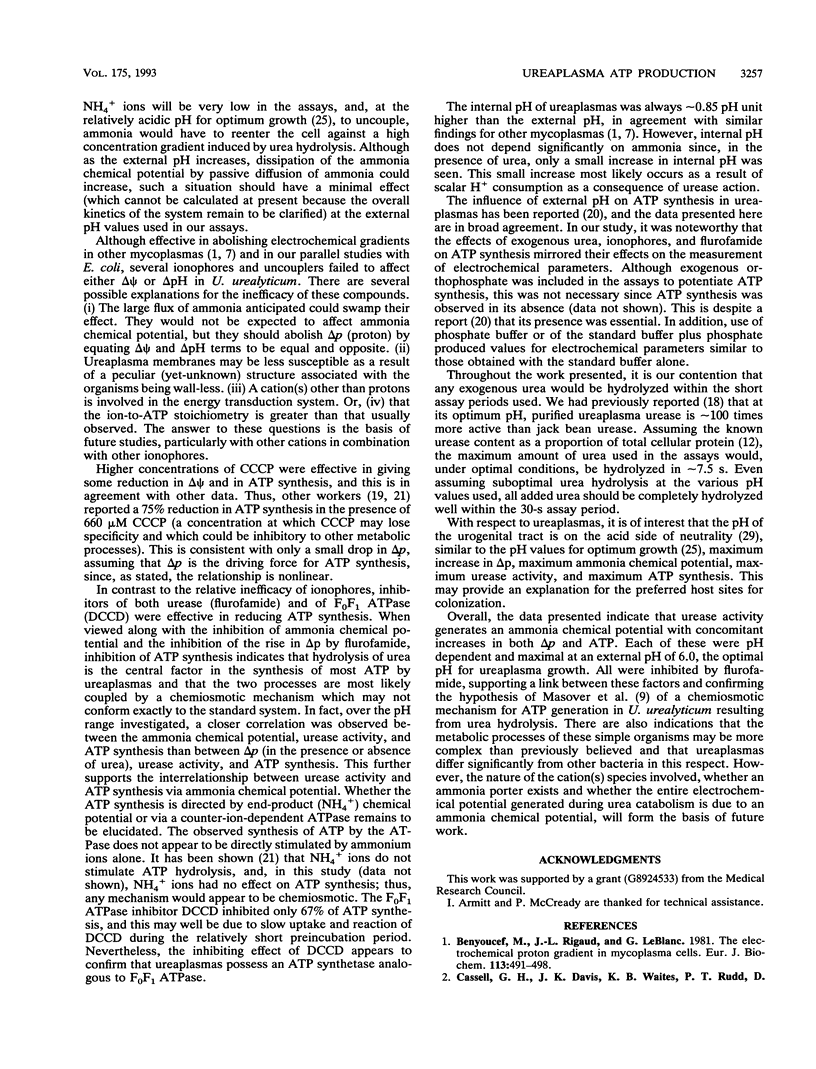
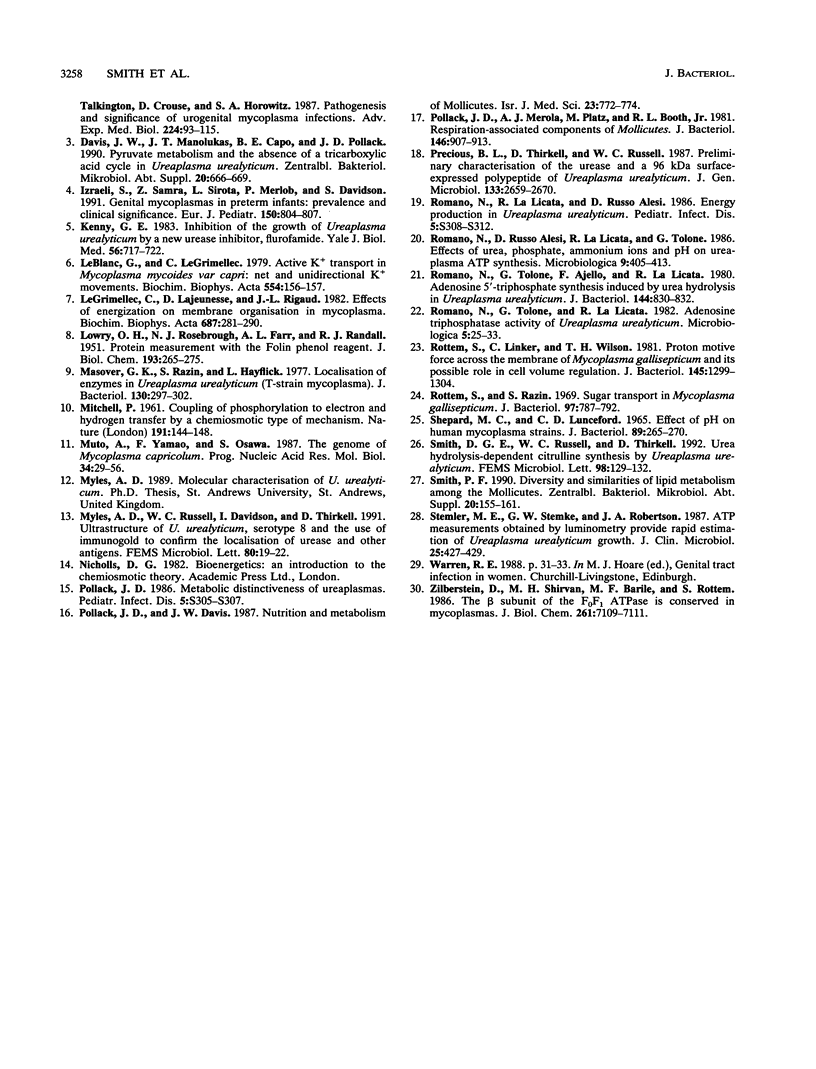
Selected References
These references are in PubMed. This may not be the complete list of references from this article.
- Benyoucef M., Rigaud J. L., Leblanc G. The electrochemical proton gradient in Mycoplasma cells. Eur J Biochem. 1981 Jan;113(3):491–498. doi: 10.1111/j.1432-1033.1981.tb05090.x. [DOI] [PubMed] [Google Scholar]
- Cassell G. H., Davis J. K., Waites K. B., Rudd P. T., Talkington D., Crouse D., Horowitz S. A. Pathogenesis and significance of urogenital mycoplasmal infections. Adv Exp Med Biol. 1987;224:93–115. doi: 10.1007/978-1-4684-8932-3_10. [DOI] [PubMed] [Google Scholar]
- Izraeli S., Samra Z., Sirota L., Merlob P., Davidson S. Genital mycoplasmas in preterm infants: prevalence and clinical significance. Eur J Pediatr. 1991 Sep;150(11):804–807. doi: 10.1007/BF02026717. [DOI] [PubMed] [Google Scholar]
- Kenny G. E. Inhibition of the growth of Ureaplasma urealyticum by a new urease inhibitor, flurofamide. Yale J Biol Med. 1983 Sep-Dec;56(5-6):717–722. [PMC free article] [PubMed] [Google Scholar]
- LOWRY O. H., ROSEBROUGH N. J., FARR A. L., RANDALL R. J. Protein measurement with the Folin phenol reagent. J Biol Chem. 1951 Nov;193(1):265–275. [PubMed] [Google Scholar]
- Le Grimellec C., Lajeunesse D., Rigaud J. L. Effects of energization on membrane organization in mycoplasma. Biochim Biophys Acta. 1982 May 7;687(2):281–290. doi: 10.1016/0005-2736(82)90556-9. [DOI] [PubMed] [Google Scholar]
- Leblanc G., Le Grimellec C. Active K+ transport in Mycoplasma mycoides var. Capri. Net and unidirectional K+ movements. Biochim Biophys Acta. 1979 Jun 13;554(1):156–167. doi: 10.1016/0005-2736(79)90015-4. [DOI] [PubMed] [Google Scholar]
- MITCHELL P. Coupling of phosphorylation to electron and hydrogen transfer by a chemi-osmotic type of mechanism. Nature. 1961 Jul 8;191:144–148. doi: 10.1038/191144a0. [DOI] [PubMed] [Google Scholar]
- Masover G. K., Razin S., Hayflick L. Localization of enzymes in Ureaplasma urealyticum (T-strain mycoplasma). J Bacteriol. 1977 Apr;130(1):297–302. doi: 10.1128/jb.130.1.297-302.1977. [DOI] [PMC free article] [PubMed] [Google Scholar]
- Muto A., Yamao F., Osawa S. The genome of Mycoplasma capricolum. Prog Nucleic Acid Res Mol Biol. 1987;34:29–58. doi: 10.1016/s0079-6603(08)60492-4. [DOI] [PubMed] [Google Scholar]
- Pollack J. D., Merola A. J., Platz M., Booth R. L., Jr Respiration-associated components of Mollicutes. J Bacteriol. 1981 Jun;146(3):907–913. doi: 10.1128/jb.146.3.907-913.1981. [DOI] [PMC free article] [PubMed] [Google Scholar]
- Pollack J. D. Metabolic distinctiveness of ureaplasmas. Pediatr Infect Dis. 1986 Nov-Dec;5(6 Suppl):S305–S307. doi: 10.1097/00006454-198611010-00023. [DOI] [PubMed] [Google Scholar]
- Precious B. L., Thirkell D., Russell W. C. Preliminary characterization of the urease and a 96 kDa surface-expressed polypeptide of Ureaplasma urealyticum. J Gen Microbiol. 1987 Sep;133(9):2659–2670. doi: 10.1099/00221287-133-9-2659. [DOI] [PubMed] [Google Scholar]
- Romano N., La Licata R., Russo Alesi D. Energy production in Ureaplasma urealyticum. Pediatr Infect Dis. 1986 Nov-Dec;5(6 Suppl):S308–S312. doi: 10.1097/00006454-198611010-00024. [DOI] [PubMed] [Google Scholar]
- Romano N., Russo Alesi D., La Licata R., Tolone G. Effects of urea phosphate, ammonium ions and pH on Ureaplasma ATP synthesis. Microbiologica. 1986 Oct;9(4):405–413. [PubMed] [Google Scholar]
- Romano N., Tolone G., Ajello F., La Licata R. Adenosine 5'-triphosphate synthesis induced by urea hydrolysis in Ureaplasma urealyticum. J Bacteriol. 1980 Nov;144(2):830–832. doi: 10.1128/jb.144.2.830-832.1980. [DOI] [PMC free article] [PubMed] [Google Scholar]
- Romano N., Tolone G., La Licata R. Adenosine triphosphatase activity of Ureaplasma urealyticum. Microbiologica. 1982 Jan;5(1):25–33. [PubMed] [Google Scholar]
- Rottem S., Linker C., Wilson T. H. Proton motive force across the membrane of Mycoplasma gallisepticum and its possible role in cell volume regulation. J Bacteriol. 1981 Mar;145(3):1299–1304. doi: 10.1128/jb.145.3.1299-1304.1981. [DOI] [PMC free article] [PubMed] [Google Scholar]
- Rottem S., Razin S. Sugar transport in Mycoplasma gallisepticum. J Bacteriol. 1969 Feb;97(2):787–792. doi: 10.1128/jb.97.2.787-792.1969. [DOI] [PMC free article] [PubMed] [Google Scholar]
- SHEPARD M. C., LUNCEFORD C. D. EFFECT OF PH ON HUMAN MYCOPLASMA STRAINS. J Bacteriol. 1965 Feb;89:265–270. doi: 10.1128/jb.89.2.265-270.1965. [DOI] [PMC free article] [PubMed] [Google Scholar]
- Smith D. G., Russell W. C., Thirkell D. Urea-hydrolysis-dependent citrulline synthesis by Ureaplasma urealyticum. FEMS Microbiol Lett. 1992 Nov 1;77(1-3):129–131. doi: 10.1016/0378-1097(92)90143-c. [DOI] [PubMed] [Google Scholar]
- Stemler M. E., Stemke G. W., Robertson J. A. ATP measurements obtained by luminometry provide rapid estimation of Ureaplasma urealyticum growth. J Clin Microbiol. 1987 Feb;25(2):427–429. doi: 10.1128/jcm.25.2.427-429.1987. [DOI] [PMC free article] [PubMed] [Google Scholar]
- Zilberstein D., Shirvan M. H., Barile M. F., Rottem S. The beta-subunit of the F1F0-ATPase is conserved in mycoplasmas. J Biol Chem. 1986 Jun 5;261(16):7109–7111. [PubMed] [Google Scholar]


